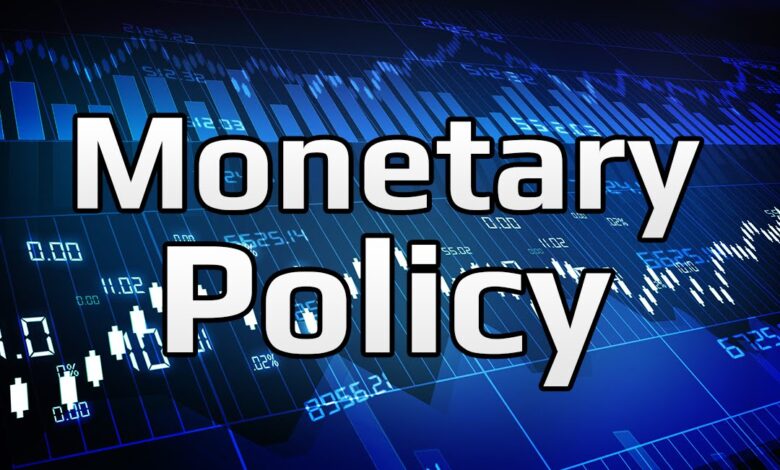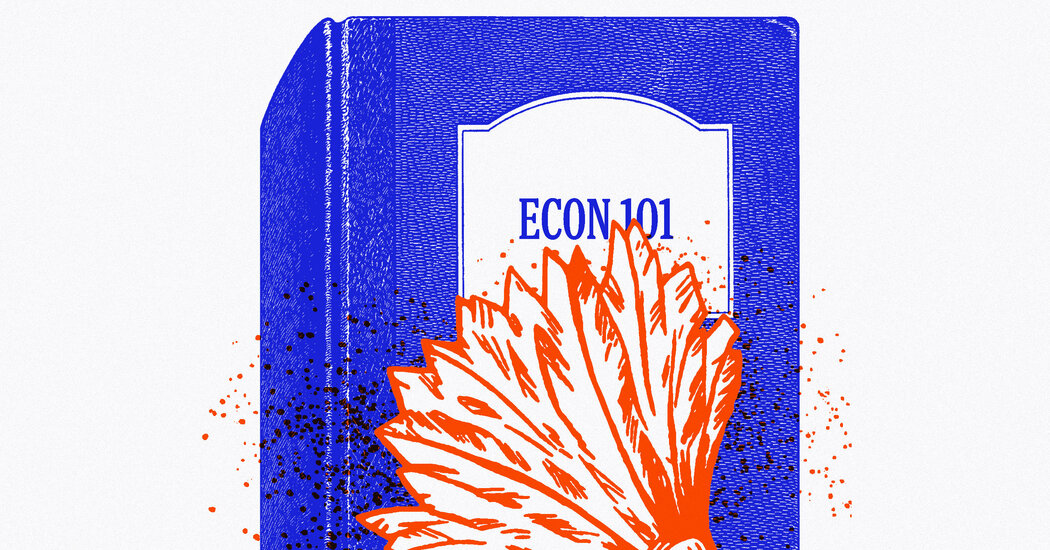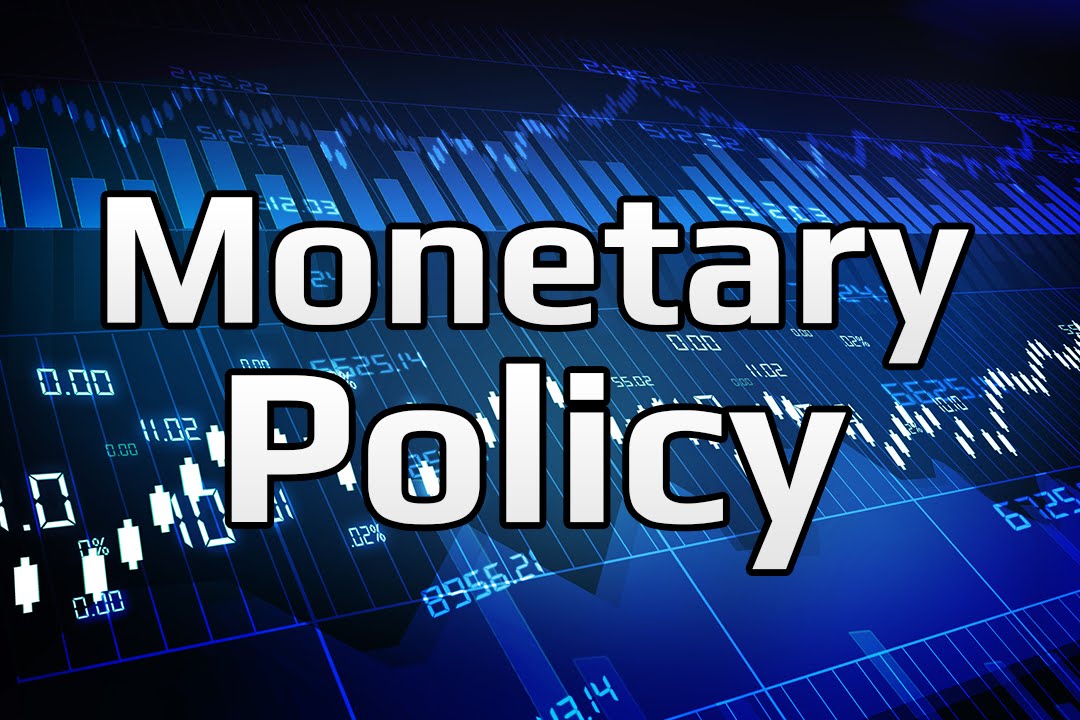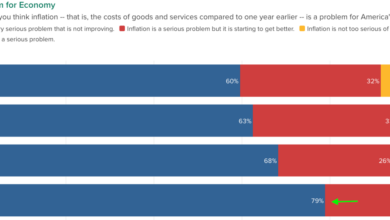
Economics Textbooks Monetary Policy A Deep Dive
Economics textbooks monetary policy explores the fascinating world of how central banks manage economies. From the different schools of thought – Keynesian, Monetarist, and New Keynesian – to the historical context and practical tools like interest rates and reserve requirements, this overview delves into the complexities of monetary policy.
The discussion covers various aspects, including the goals and objectives of monetary policy, the trade-offs involved, and the crucial role of inflation targeting. It also examines the impact of monetary policy on economic fluctuations, financial markets, and international relations. Finally, the limitations and criticisms of monetary policy, along with future trends, are evaluated.
Introduction to Monetary Policy in Economics Textbooks
Monetary policy, a cornerstone of macroeconomic management, involves actions undertaken by a central bank to manipulate the money supply and credit conditions to influence the economy’s overall performance. Economics textbooks typically detail how central banks use various tools, like interest rate adjustments and reserve requirements, to achieve objectives such as price stability, full employment, and sustainable economic growth. Understanding the different schools of thought and historical contexts surrounding monetary policy is crucial for grasping its complexities and effectiveness.Economics textbooks present monetary policy as a powerful yet delicate tool.
Central banks must carefully consider the potential short-term and long-term effects of their decisions, weighing the risks of inflation and deflation, unemployment and economic stagnation. The choices made often have far-reaching consequences for businesses, consumers, and the overall economic well-being of a nation.
Different Schools of Thought on Monetary Policy
Various schools of economic thought offer differing perspectives on the role and effectiveness of monetary policy. Keynesian economics emphasizes the role of aggregate demand in driving economic activity. Monetarism, on the other hand, highlights the importance of the money supply in influencing inflation and output. New Keynesian economics attempts to bridge the gap between these two approaches, incorporating elements of both into a more comprehensive framework.
- Keynesian Economics focuses on using monetary policy to manage aggregate demand. Proponents believe that during economic downturns, central banks can stimulate the economy by lowering interest rates and increasing the money supply, thereby encouraging investment and consumption. This approach recognizes the potential for economic fluctuations and the role of government intervention to stabilize the economy. The Great Depression, for example, highlighted the potential for significant economic downturns and the need for active government intervention to mitigate their impact.
- Monetarism emphasizes the importance of the money supply in determining the price level and inflation. Proponents argue that excessive money growth inevitably leads to inflation. They advocate for a stable and predictable monetary policy focused on controlling the money supply. The inflation experienced in the 1970s in some countries, for example, fueled the rise of monetarist thought.
- New Keynesian Economics attempts to reconcile the insights of Keynesian and Monetarist schools. It recognizes the limitations of monetary policy, particularly in the short run, while also acknowledging the importance of monetary policy in influencing aggregate demand. It incorporates aspects of microeconomic behavior into macroeconomic models, which allows for more nuanced understanding of the impacts of monetary policy.
Historical Context of Monetary Policy
The application of monetary policy has evolved significantly across different economic systems and historical periods. Early forms of monetary policy often involved attempts to control the money supply through coinage and the issuance of paper money. The rise of central banks in the 20th century marked a significant shift, allowing for more systematic and coordinated management of monetary policy.
The increasing complexity of globalized economies and financial markets has presented new challenges and opportunities for monetary policy implementation.
| School of Thought | Key Tenet | Policy Implications |
|---|---|---|
| Keynesian | Monetary policy can significantly influence aggregate demand, and thus economic output, by adjusting interest rates and money supply. | Lowering interest rates and increasing money supply during recessions to stimulate demand. |
| Monetarist | Changes in the money supply directly affect the price level and inflation. | Maintaining a stable and predictable growth rate of the money supply to control inflation. |
| New Keynesian | Monetary policy can affect aggregate demand, but its effectiveness is influenced by various factors, including market expectations and microeconomic behavior. | Careful consideration of market expectations and microeconomic conditions when formulating monetary policy. |
Tools of Monetary Policy
Central banks wield various tools to influence the economy’s health, employment, and inflation rates. These tools, often referred to as monetary policy instruments, are crucial for maintaining stability and fostering sustainable growth. Understanding how these instruments work and their impact is essential for anyone interested in macroeconomics and financial markets.
Interest Rates
Central banks frequently adjust interest rates to steer the economy. Lowering interest rates encourages borrowing and spending, stimulating economic activity. Conversely, raising interest rates discourages borrowing, curbing spending, and potentially reducing inflation. This adjustment mechanism is a powerful tool for managing economic cycles. The Federal Reserve, for instance, uses the federal funds rate as a key benchmark for influencing broader interest rates in the economy.
Changes in this rate ripple through various sectors, affecting everything from mortgages to credit card interest rates.
Reserve Requirements
Reserve requirements dictate the minimum percentage of deposits that banks must hold in reserve, either in their account at the central bank or as vault cash. Increasing reserve requirements reduces the amount of money banks can lend, thereby decreasing the money supply. Conversely, lowering reserve requirements increases the amount banks can lend, expanding the money supply. This tool directly affects the lending capacity of the banking system and can be a powerful instrument for influencing the overall money supply.
A change in reserve requirements can impact the availability of credit to businesses and consumers.
Economics textbooks often describe monetary policy as a crucial tool for managing inflation and economic growth. However, the real-world application of these theories can be complex, especially when considering recent events like the Carroll verdict, and its implications for Haley and Trump. The political fallout from the carroll verdict haley trump case highlights the interplay between economic policy and political realities, prompting further discussion about the effectiveness of monetary policy in a politically charged environment.
Ultimately, the textbook models provide a valuable framework, but understanding the complexities of the political landscape is also key.
Open Market Operations
Open market operations involve the buying and selling of government securities by the central bank. When the central bank buys securities, it injects money into the banking system, increasing the money supply. Conversely, selling securities withdraws money, decreasing the money supply. This approach is often a crucial tool for fine-tuning the money supply and managing short-term fluctuations in the economy.
The Federal Reserve frequently uses open market operations to maintain stability in money markets.
Table: Mechanics of Monetary Policy Tools
| Monetary Policy Tool | Action | Impact on Money Supply | Impact on Interest Rates | Impact on Credit Markets | Impact on Inflation | Impact on Economic Growth |
|---|---|---|---|---|---|---|
| Interest Rates (e.g., federal funds rate) | Increase | Decrease | Increase | Decrease | Decrease | Potentially decrease |
| Interest Rates (e.g., federal funds rate) | Decrease | Increase | Decrease | Increase | Increase | Potentially increase |
| Reserve Requirements | Increase | Decrease | Increase | Decrease | Decrease | Potentially decrease |
| Reserve Requirements | Decrease | Increase | Decrease | Increase | Increase | Potentially increase |
| Open Market Operations (Buying Securities) | Buy | Increase | Decrease | Increase | Increase | Potentially increase |
| Open Market Operations (Selling Securities) | Sell | Decrease | Increase | Decrease | Decrease | Potentially decrease |
Monetary Policy Goals and Objectives: Economics Textbooks Monetary Policy
Monetary policy, a crucial tool for managing a nation’s economy, aims to achieve a stable and prosperous environment. Central banks, entrusted with this responsibility, pursue specific objectives that influence various economic indicators. These goals, while often interconnected, require careful consideration of potential trade-offs and challenges. This section delves into the key objectives, the intricate balance required, and the role of inflation targeting in achieving these goals.Understanding the interplay between these goals is critical for policymakers and economists.
Different policy choices will prioritize certain objectives over others, leading to various outcomes. A deep understanding of these dynamics is essential for evaluating the effectiveness of monetary policy in promoting long-term economic stability.
Primary Goals of Monetary Policy
Central banks worldwide typically pursue several primary goals. These objectives, often overlapping and intertwined, represent the desired outcomes of monetary policy actions. A healthy economy thrives on a balance among these objectives.
- Price Stability: Maintaining a low and stable inflation rate is paramount. High inflation erodes purchasing power, distorts economic signals, and creates uncertainty. A stable price level ensures that consumers and businesses can make informed decisions, fostering a predictable economic environment.
- Full Employment: A robust labor market, characterized by low unemployment, is a key indicator of economic well-being. Monetary policy plays a role in creating an environment conducive to job creation and reducing unemployment to levels consistent with the economy’s productive capacity.
- Sustainable Economic Growth: A healthy economy should expand its output over time. Monetary policy can influence the rate of economic growth by influencing investment, consumption, and overall demand. A balanced approach is essential to prevent unsustainable booms and busts.
- Financial Stability: A stable financial system is essential for the smooth functioning of the economy. Monetary policy can contribute to financial stability by influencing interest rates, credit conditions, and the overall risk appetite within the financial sector.
Trade-offs and Challenges
Achieving these goals simultaneously often presents trade-offs. For example, policies aimed at reducing inflation might lead to slower economic growth or higher unemployment in the short run. The challenge for policymakers is to strike a balance between these competing objectives, carefully weighing the costs and benefits of each policy decision.
Inflation Targeting
Inflation targeting has become a prominent feature of modern monetary policy frameworks. This approach involves explicitly targeting a specific inflation rate, usually a low positive number. This clarity provides transparency and anchors expectations, which can help maintain price stability.
The Phillips Curve and its Implications
The Phillips Curve illustrates the inverse relationship between inflation and unemployment. The original concept suggests that lower unemployment rates often come at the cost of higher inflation, and vice versa.
The Phillips Curve relationship, while historically observed, is not universally consistent. Modern macroeconomic understanding acknowledges the complexities of this relationship.
The Phillips Curve’s implications for monetary policy are significant. Central banks must carefully consider the short-run trade-offs between inflation and unemployment when making policy decisions. They must balance the need for price stability with the desire to maintain full employment.
Monetary Policy and Economic Fluctuations

Monetary policy plays a crucial role in managing the ups and downs of the economy. Central banks use various tools to influence interest rates, credit conditions, and the overall money supply to steer the economy towards desired outcomes. This section explores how monetary policy can be deployed to moderate economic fluctuations, from the depths of recessions to the potential overheating of booms.
Understanding the short-run and long-run impacts of these actions is critical for effective economic management.Monetary policy acts as a powerful tool for influencing the economy’s pace and trajectory. When the economy is experiencing a downturn, central banks typically employ expansionary policies to stimulate demand and growth. Conversely, during periods of rapid growth and inflation, contractionary policies are implemented to cool down the economy and prevent overheating.
The effectiveness of these policies depends on various factors, including the specific economic context and the credibility of the central bank’s commitment to its goals.
Managing Recessions with Monetary Policy
Central banks often lower interest rates during recessions to encourage borrowing and investment. Lower rates make it cheaper for businesses to finance expansion and consumers to purchase goods and services. This increased borrowing and spending stimulates aggregate demand, pushing the economy back toward full employment. The effectiveness of this policy depends on the responsiveness of businesses and consumers to lower interest rates.
History shows that significant rate cuts can be successful in preventing severe economic downturns.
Economics textbooks often discuss monetary policy, but it’s hard to grasp the real-world impact without looking at examples. For instance, consider the soaring prices of homes in California, with some reaching over $2 million. 2 million dollar homes california highlight the potential influence of monetary policy on asset bubbles, which are often examined in these same textbooks.
Understanding these intricate connections is key to interpreting economic trends and their effects on different segments of society.
Managing Booms with Monetary Policy
Conversely, when the economy experiences a period of rapid growth, characterized by rising inflation and potential overheating, central banks use contractionary monetary policies. These policies typically involve raising interest rates to curb borrowing and spending. Higher rates make it more expensive for businesses and consumers to borrow, reducing aggregate demand and thus tempering inflation. The goal is to avoid inflationary pressures that can erode purchasing power and disrupt the economy.
Short-Run and Long-Run Effects of Monetary Policy
The effects of monetary policy are not immediate and often manifest differently in the short run versus the long run. In the short run, changes in interest rates can quickly impact borrowing costs and spending patterns. In the long run, the effects are more complex, potentially impacting inflation, unemployment, and economic growth. Central banks need to carefully consider these short-term and long-term implications when formulating policy responses.
Central banks must weigh the potential trade-offs between short-term economic stabilization and long-term price stability.
Examples of Monetary Policy Responses to Economic Crises
The 2008 financial crisis saw significant interventions by central banks worldwide. Many central banks lowered interest rates to near zero and implemented quantitative easing programs (QE) to inject liquidity into financial markets. These measures aimed to stabilize the financial system and prevent a deeper economic recession. Similarly, during the COVID-19 pandemic, central banks around the world responded with unprecedented monetary easing, including near-zero interest rates and substantial QE programs, to mitigate the economic fallout.
These actions demonstrate the crucial role of monetary policy in responding to major economic crises.
Effectiveness of Different Monetary Policy Responses
| Monetary Policy Response | Economic Context | Effectiveness | Examples |
|---|---|---|---|
| Interest Rate Cuts | Recessions, low inflation | Generally effective in stimulating demand | 2008 financial crisis, 2020 COVID-19 pandemic |
| Interest Rate Hikes | Booms, high inflation | Generally effective in curbing demand and inflation | 1980s inflationary periods |
| Quantitative Easing | Severe financial crises, low interest rates | Can be effective in boosting liquidity and preventing deflation | 2008 financial crisis |
The effectiveness of different monetary policy responses varies across economic contexts. Factors such as the severity of the crisis, the state of the economy, and the credibility of the central bank all influence the outcomes. Careful consideration of these factors is crucial for designing effective monetary policies.
Monetary Policy and Financial Markets

Monetary policy, while aiming to manage the overall economy, significantly impacts financial markets. These markets, including bond and stock markets, react to changes in interest rates, reserve requirements, and the overall monetary environment. Understanding this interplay is crucial for policymakers and market participants alike.The relationship between monetary policy and financial markets is complex and dynamic. Central bank actions, such as adjusting the federal funds rate, influence borrowing costs for businesses and consumers, thereby affecting investment and spending decisions.
These decisions, in turn, ripple through the financial markets, impacting asset prices and market liquidity.
Bond Market Impacts
Changes in monetary policy directly affect bond prices. Lowering interest rates typically leads to higher bond prices as existing bonds become more attractive compared to newly issued bonds with lower yields. Conversely, increasing interest rates decrease bond prices. This is because the fixed income stream of existing bonds becomes less valuable relative to bonds issued at the higher rates.
For example, if the Federal Reserve lowers the federal funds rate, investors might expect lower returns on future bonds, causing them to bid up the prices of existing bonds to capture the higher yield.
Stock Market Responses
Stock markets are influenced by monetary policy, though the relationship is often more indirect. Lower interest rates can stimulate investment and economic growth, potentially leading to higher corporate profits and stock valuations. Conversely, tighter monetary policy, intended to curb inflation, can slow economic growth and reduce corporate profits, thus impacting stock prices. A good example is the 2008 financial crisis, where the Fed’s aggressive easing of monetary policy helped to stabilize the market.
Financial Intermediaries’ Role
Financial intermediaries, like banks and investment firms, play a crucial role in transmitting monetary policy effects to the wider economy. Changes in reserve requirements, discount rates, or open market operations affect the cost and availability of credit for these institutions. These changes, in turn, influence the lending practices of financial institutions, impacting the availability of loans to businesses and consumers.
This is vital as financial intermediaries act as the conduits through which monetary policy impacts the real economy.
Monetary Policy Implementation Risks
Implementing monetary policy carries inherent risks. Unexpected market reactions, such as sudden shifts in investor sentiment or a sharp rise in inflation, can complicate the desired outcomes. For instance, if a policy action is perceived as overly aggressive, it can lead to a sharp sell-off in the bond market, undermining the intended effects. Moreover, the time lag between implementing a policy and observing its effects can make it difficult to fine-tune policy responses to economic developments.
Economics textbooks often detail monetary policy, but rarely delve into how it impacts employee ownership structures within private equity firms. For instance, KKR’s private equity employee ownership initiatives, as highlighted in this recent article about kkr private equity employee ownership , offer a fascinating case study. Ultimately, understanding the complex interplay between these different economic forces is crucial for a well-rounded understanding of monetary policy’s real-world effects.
Table: Monetary Policy Actions and Financial Market Impacts
| Monetary Policy Action | Bond Market | Stock Market | Financial Intermediaries |
|---|---|---|---|
| Interest Rate Increase | Bond prices decrease, yields increase | Stock prices potentially decrease | Reduced availability of credit, higher lending costs |
| Interest Rate Decrease | Bond prices increase, yields decrease | Stock prices potentially increase | Increased availability of credit, lower lending costs |
| Open Market Purchase | Bond prices increase, yields decrease | Potentially positive impact on stock prices | Increased liquidity, reduced borrowing costs |
| Open Market Sale | Bond prices decrease, yields increase | Potentially negative impact on stock prices | Reduced liquidity, increased borrowing costs |
International Aspects of Monetary Policy
International monetary policy is not a solitary endeavor; it’s a complex web of interconnected actions and reactions across nations. Understanding how different countries coordinate their policies, the influence of international organizations, and the challenges of global imbalances is crucial to comprehending the modern global economy. Effective monetary policy in one country can have ripple effects on others, making international coordination essential.The globalized nature of financial markets and trade means that monetary policy decisions in one country can significantly impact others.
For instance, a sudden interest rate hike in a major economy can trigger capital flight from other nations, leading to currency depreciation and economic instability. Conversely, coordinated monetary policies can stabilize exchange rates and promote global economic growth.
Coordination of Monetary Policy Across Countries
Effective monetary policy coordination across countries requires a degree of harmonization in policy objectives and strategies. This necessitates open communication and collaboration between central banks to anticipate and mitigate potential disruptions to the global economy. Central banks often engage in bilateral and multilateral consultations to share information, identify potential risks, and coordinate responses to economic challenges. These efforts aim to minimize the adverse effects of domestic policies on other nations.
Examples include the G20 meetings, where central bankers from various countries discuss and coordinate their policies.
Role of International Organizations in Shaping Global Monetary Policy
International organizations like the International Monetary Fund (IMF) play a vital role in shaping global monetary policy. The IMF provides a platform for countries to share experiences, analyze economic trends, and develop best practices in monetary policy. It offers technical assistance to developing nations in strengthening their monetary institutions and policies. The IMF also plays a critical role in providing financial support during economic crises, encouraging responsible monetary policy practices globally.
The IMF’s conditionality often includes requirements for fiscal discipline and sound monetary policy reforms as a condition for financial assistance.
Challenges of Managing Global Economic Imbalances
Managing global economic imbalances, such as persistent current account deficits or surpluses, is a major challenge for international monetary policy. These imbalances can arise from differences in saving and investment rates, exchange rate regimes, and government policies. Sustained imbalances can lead to currency volatility, trade tensions, and macroeconomic instability. One example of a global economic imbalance is the large trade surplus of some Asian economies relative to others.
Economics textbooks often delve into monetary policy, but the recent news surrounding the trump trial judge campaign raises intriguing questions about the real-world application of these concepts. While academic models illustrate how central banks manipulate interest rates, the complexities of political maneuvering and judicial appointments highlight the human element that often shapes economic realities. Ultimately, understanding monetary policy requires considering both theoretical frameworks and the practical, political context.
These imbalances can be managed through a combination of fiscal and monetary policies, exchange rate adjustments, and international cooperation.
Comparison and Contrast of Monetary Policy Strategies in Different Regions
Monetary policy strategies vary significantly across different regions, reflecting differing economic structures, institutional frameworks, and policy priorities. For example, countries with emerging economies often face unique challenges related to inflation control and financial stability. Central banks in these regions might adopt strategies that prioritize price stability while also promoting financial inclusion and economic growth. Developed economies, on the other hand, might focus more on maintaining low and stable inflation.
The European Central Bank (ECB) and the Federal Reserve (Fed), for instance, utilize different tools and approaches to manage monetary policy due to their distinct economic circumstances. These differences highlight the need for a nuanced understanding of regional contexts when analyzing monetary policy strategies.
Limitations and Criticisms of Monetary Policy
Monetary policy, while a powerful tool for managing the economy, is not without its limitations. Economists and policymakers alike recognize that the effectiveness of monetary policy can be hampered by various factors. These limitations often stem from the inherent complexity of the economy and the challenges in predicting its future trajectory. Understanding these limitations is crucial for formulating effective and well-targeted policies.The inherent complexities of the modern economy and the difficulty in anticipating future economic developments significantly affect the effectiveness of monetary policy.
Economics textbooks often gloss over the complexities of monetary policy, but the recent results of the New Hampshire Democratic primary ( results new hampshire democratic primary ) highlight how economic anxieties influence voter choices. Ultimately, understanding the real-world implications of these policies, as discussed in those textbooks, requires considering the nuanced political landscape, like the one we’re seeing now.
This all adds another layer of nuance to the study of monetary policy in economics textbooks.
Central banks, while employing sophisticated models and data analysis, cannot perfectly predict the responses of various market participants to policy changes. This inherent uncertainty can lead to unintended consequences or reduced policy impact.
Expectations and Uncertainty
Monetary policy effectiveness is deeply intertwined with economic actors’ expectations. If individuals and businesses anticipate a particular policy response, their behavior may adjust in advance, potentially neutralizing the intended effect of the policy. For instance, if a central bank signals an intention to increase interest rates, individuals might anticipate higher borrowing costs and reduce their spending, thereby mitigating the desired impact on inflation.
Conversely, if expectations are not accurately captured, the policy’s effect might be stronger or weaker than intended. Furthermore, unexpected economic shocks, such as sudden changes in global commodity prices or geopolitical events, can significantly alter the economic landscape, rendering pre-existing policy prescriptions ineffective.
Time Lags
Monetary policy implementation is not instantaneous. There are significant time lags between a policy decision and its full impact on the economy. These lags can be categorized into three types: recognition lag, implementation lag, and impact lag. The recognition lag refers to the time it takes for policymakers to recognize the need for a policy change. The implementation lag involves the time needed to enact the policy decision, which can be influenced by bureaucratic processes and political considerations.
Finally, the impact lag is the time it takes for the policy to have a measurable effect on economic variables like inflation or output. These time lags make it difficult for monetary policy to effectively address immediate economic challenges. For example, if inflation rises unexpectedly, by the time the central bank implements a policy response to curb inflation, the economy might have already experienced some negative consequences.
Limitations in Addressing Structural Issues
Monetary policy, while effective in managing cyclical fluctuations, has limited ability to address structural economic issues. Structural issues, such as inadequate infrastructure, skills gaps, or high levels of inequality, are long-term problems that require fundamental changes in the economic structure. Monetary policy primarily focuses on aggregate demand, whereas structural issues require interventions focused on supply-side factors, such as investments in education, infrastructure, or technological advancements.
For example, a country experiencing persistent high unemployment due to a mismatch between skills and available jobs would not be effectively addressed by adjustments in interest rates. Direct investments in education and training programs, rather than monetary policy adjustments, are needed to improve the situation.
Future Trends in Monetary Policy
Monetary policy, the art and science of managing a nation’s money supply and credit conditions, is constantly evolving. The global landscape is dynamic, with technological advancements, shifting economic models, and emerging challenges reshaping the way central banks operate. Understanding these future trends is crucial for policymakers and anyone interested in the economy.The future of monetary policy is characterized by a need for adaptation.
Central banks will need to navigate a complex interplay of factors, including evolving economic structures, the growing influence of digital currencies, and the potential for alternative economic models to challenge conventional wisdom. This adaptation requires not just technical adjustments but also a nuanced understanding of the societal and political context in which monetary policy operates.
Unconventional Policies and Their Evolution, Economics textbooks monetary policy
Central banks have increasingly employed unconventional monetary policies, such as quantitative easing (QE), in response to economic downturns. These policies involve injecting liquidity into financial markets by purchasing assets without the aim of immediately lowering interest rates. The future will likely see a continued use of these tools, possibly with modifications. For example, central banks might experiment with different asset classes for purchases, potentially including private sector assets to directly stimulate specific sectors.
Emerging Challenges and Opportunities
The global environment presents both challenges and opportunities for monetary policy. The rise of new technologies, like cryptocurrencies, poses a challenge to traditional monetary systems. The changing structure of the financial system, with increased digitalization and fintech innovations, demands a re-evaluation of risk management and regulatory frameworks. The potential for increased global interconnectedness presents an opportunity for collaboration on monetary policy issues, though achieving consensus on these policies across diverse economies remains a hurdle.
Technological Advancements
Technological advancements, particularly in digital payments and financial technologies, are transforming the way individuals and businesses interact with the financial system. The implications for monetary policy are significant. Central banks will need to understand how these technologies influence money creation, transaction patterns, and overall financial stability. The development of central bank digital currencies (CBDCs) is another significant development.
These digital forms of money have the potential to improve efficiency in financial transactions and payments.
Impact of Alternative Economic Models
Alternative economic models, such as those emphasizing sustainability and inclusivity, are gaining traction. These models often challenge traditional assumptions about economic growth and its relationship to monetary policy. For example, the concept of a “green” monetary policy, focusing on investments that promote environmental sustainability, may gain prominence. The integration of environmental, social, and governance (ESG) factors into monetary policy frameworks could be a response to these evolving models.
The challenge will be balancing these alternative considerations with the traditional goals of price stability and economic growth.
Closure
In conclusion, economics textbooks monetary policy reveals a multifaceted and dynamic field. Understanding the intricate interplay between theory and practice is essential for navigating the complexities of modern economies. This exploration provides a solid foundation for grasping the significance of monetary policy in shaping economic outcomes.
User Queries
What are the key differences between Keynesian and Monetarist schools of thought on monetary policy?
Keynesians emphasize demand-side management, advocating for active government intervention in the economy through monetary policy to stimulate aggregate demand. Monetarists, conversely, focus on controlling the money supply, believing that stable money growth is crucial for price stability. New Keynesians combine aspects of both, recognizing the role of sticky prices and wages in impacting economic outcomes.
How does inflation targeting affect monetary policy decisions?
Inflation targeting provides a clear framework for central banks to make policy decisions, focusing on achieving a predetermined inflation rate. This approach reduces uncertainty and improves transparency, guiding central banks towards maintaining price stability.
What are some examples of unconventional monetary policy tools?
Unconventional tools, employed during economic crises, include quantitative easing, negative interest rates, and forward guidance. These measures aim to stimulate economic activity when traditional tools are insufficient.





